Ericsson had 10 minutes to tell us about its three key products it was showing off in Barcelona -- here are the results in photo essay format
March 6, 2012
BARCELONA -- Mobile World Congress 2012 -- With more than 60,000 people running around the Fira show grounds in Barcelona this year, what would visitors to the Ericsson AB (Nasdaq: ERIC) hall be shown by the attending staff if they had just a few precious minutes to get the highlights?
Ericsson was the first of six mobile network equipment vendors we visited with a photographer at this year's MWC and we gave them all the exact same challenge: Show us your three market leading/cutting edge/most important products and tell us about them in just 10 minutes.
The idea of the exercise is to determine what an average visitor might be shown if they were trying to get a sense for what the major mobile vendors are focused on right now. All the companies were given the exact same advance brief, treatment and opportunity, to which some responded more readily than others.
So here are the results of the Ericsson tour with the overall grade, based on perceived performance, relevance and other factors (some rather subjective), provided with the final picture caption.
Click on the picture below to start the tour. 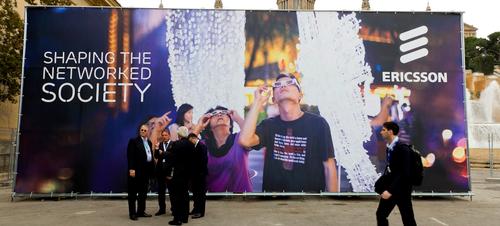
All photos taken by Siqui Sánchez/Getty Images, but he's not to blame for the selection process or the captions.
You can see how Ericsson and its peers performed in 2011 (yes, we do this each year!) by checking out last year's tours below:
MWC 2011 Photos: AlcaLu Booth Tour
MWC 2011 Photos: Huawei Booth Tour
MWC 2011 Photos: ZTE Booth Tour
MWC 2011 Photos: Ericsson Booth Tour
MWC 2011 Photos: Cisco Booth Tour
MWC 2011 Photos: NSN Booth Tour
MWC 2011 Photos: NEC Booth Tour
MWC 2011 Photo Tour Report Card
— Ray Le Maistre, International Managing Editor, Light Reading
Grand Entrance It wasn't hard to find the Ericsson hall at the top of the show grounds.Purple Expressionism
It wasn't hard to find the Ericsson hall at the top of the show grounds.Purple Expressionism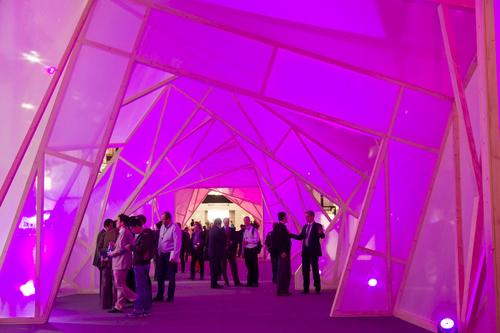 Entering the Ericsson hall was a colorful experience with a hint of expressionist influence. Would Dr. Caligari be showing us around today?Walk This Way
Entering the Ericsson hall was a colorful experience with a hint of expressionist influence. Would Dr. Caligari be showing us around today?Walk This Way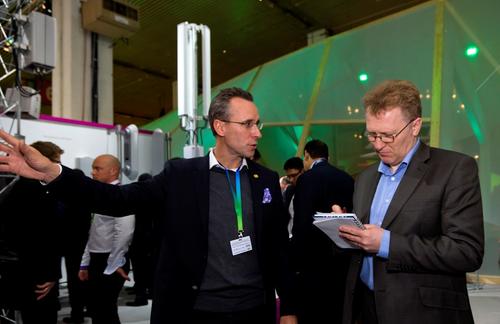 No, it wasn't Caligari ... Our guide, as in previous years, was Ericsson's Director of Network Solutions Peter Linder (who, despite what the picture might suggest, was not sporting a strap-on radio antenna kit). We started the clock and off he set on his key facts about the first product, which was very much HetNet rather than HotNot...Lean On Me
No, it wasn't Caligari ... Our guide, as in previous years, was Ericsson's Director of Network Solutions Peter Linder (who, despite what the picture might suggest, was not sporting a strap-on radio antenna kit). We started the clock and off he set on his key facts about the first product, which was very much HetNet rather than HotNot...Lean On Me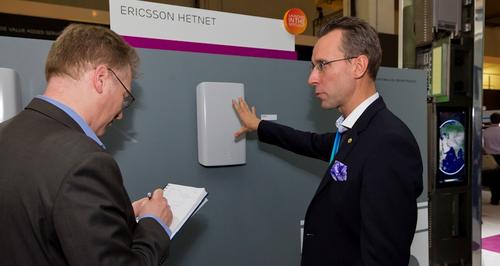 The product in question was the pRBS, Ericsson pico base station, which, as you can see, is certainly pico and was being announced to the world as we chatted. Linder said it is designed to provide HSPA, LTE and Wi-Fi connectivity in the main spectrum bands used in Europe, as well as some of those used in North American, and can be used to add small pockets of capacity as part of the broader network coverage. Commercial availability will be "later this year," which made us think of Christmas. Only an Idiot Would Stick His Finger in That Port
The product in question was the pRBS, Ericsson pico base station, which, as you can see, is certainly pico and was being announced to the world as we chatted. Linder said it is designed to provide HSPA, LTE and Wi-Fi connectivity in the main spectrum bands used in Europe, as well as some of those used in North American, and can be used to add small pockets of capacity as part of the broader network coverage. Commercial availability will be "later this year," which made us think of Christmas. Only an Idiot Would Stick His Finger in That Port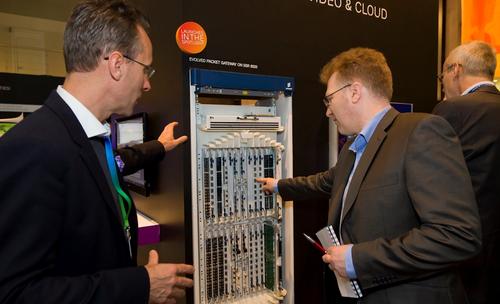 Next up was the SSR (Smart Services Router) 8020, which, said Linder, is designed to consolidate the functionality of multiple products into a single physical chassis. The first application that can be housed on the SSR is the Evolved Packet Gateway (EPG), the new mobile packet core platform for handling data traffic. Australian carrier Telstra is currently deploying the SSR with the EPG capability, the Ericsson man said. Other applications due to be housed on the SSR include deep packet inspection (DPI) and Wi-Fi network management. Services Router or Art Deco Construct?
Next up was the SSR (Smart Services Router) 8020, which, said Linder, is designed to consolidate the functionality of multiple products into a single physical chassis. The first application that can be housed on the SSR is the Evolved Packet Gateway (EPG), the new mobile packet core platform for handling data traffic. Australian carrier Telstra is currently deploying the SSR with the EPG capability, the Ericsson man said. Other applications due to be housed on the SSR include deep packet inspection (DPI) and Wi-Fi network management. Services Router or Art Deco Construct?  Never mind the packet core blades -- was this product designed by a fan of the Art Deco movement? What with that and the strong hint of expressionism at the entrance to the hall, we weren't sure what we'd find next. Would a surreal fixed-line handset a la Salvador Dali await us around the corner? Alright My SON!
Never mind the packet core blades -- was this product designed by a fan of the Art Deco movement? What with that and the strong hint of expressionism at the entrance to the hall, we weren't sure what we'd find next. Would a surreal fixed-line handset a la Salvador Dali await us around the corner? Alright My SON!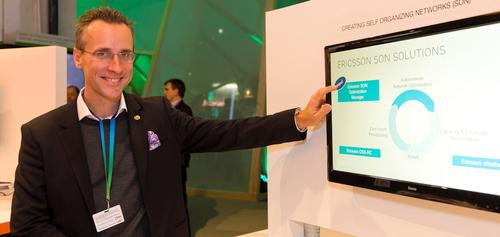 But there was nothing surreal about the third product on Ericsson's line-up -- its SON (self-organizing network) Optimization Manager, which, as Linder pointed out here, is "new" (though not sparkly).Unleashing the Potential
But there was nothing surreal about the third product on Ericsson's line-up -- its SON (self-organizing network) Optimization Manager, which, as Linder pointed out here, is "new" (though not sparkly).Unleashing the Potential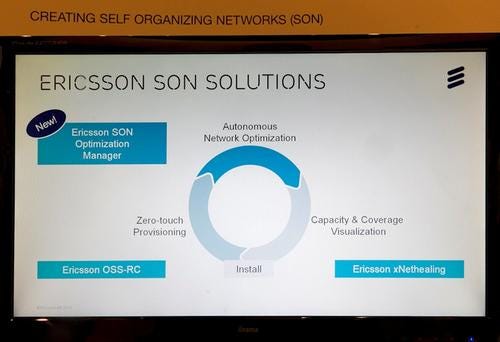 Linder explained that there are a "lot of latent capabilities that can be unleashed" if networks are properly optimized and that this will become increasingly important as small cells are added to the network topology. The general feeling in the industry is that the capacity crunch has not yet started in earnest and that operators need to find every way possible to maximize their network potential and not waste any capacity or capabilities. "This is all about fine tuning the network," stated Linder.Any More Time?
Linder explained that there are a "lot of latent capabilities that can be unleashed" if networks are properly optimized and that this will become increasingly important as small cells are added to the network topology. The general feeling in the industry is that the capacity crunch has not yet started in earnest and that operators need to find every way possible to maximize their network potential and not waste any capacity or capabilities. "This is all about fine tuning the network," stated Linder.Any More Time?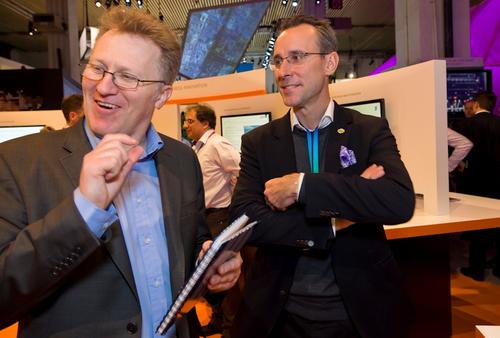 Linder had completed his three-product overview with just a small amount of time to go, so he just added the broad observation about the big focus on small cells that's now prevalent before we stopped the clock.The Martini & the Bellini
Linder had completed his three-product overview with just a small amount of time to go, so he just added the broad observation about the big focus on small cells that's now prevalent before we stopped the clock.The Martini & the Bellini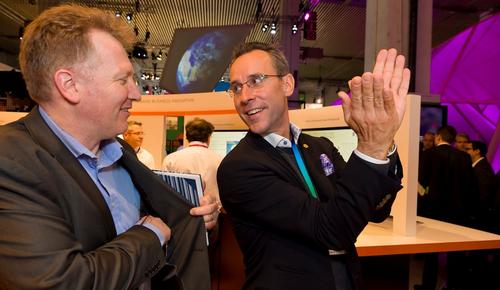 As we packed up and prepared to head for the exit, Linder regaled us with a theory that involved Martinis -- in the picture above he is shamefully, at 10.30am, whetting our appetite by making the shape of a Martini glass -- and Bellinis. So we headed straight for the bar (of the coffee variety, of course) to ponder Ericsson's efforts. The combination of small-cell developments, multifunctional core capabilities and accompanying service provider IT (SPIT) management tools for greater network utilization and efficiency was a logical and well-constructed group of products to present and the execution was up to the usual high standards.
As we packed up and prepared to head for the exit, Linder regaled us with a theory that involved Martinis -- in the picture above he is shamefully, at 10.30am, whetting our appetite by making the shape of a Martini glass -- and Bellinis. So we headed straight for the bar (of the coffee variety, of course) to ponder Ericsson's efforts. The combination of small-cell developments, multifunctional core capabilities and accompanying service provider IT (SPIT) management tools for greater network utilization and efficiency was a logical and well-constructed group of products to present and the execution was up to the usual high standards.
This year, Ericsson's grade is A.
You May Also Like









